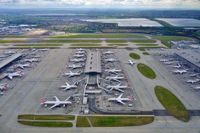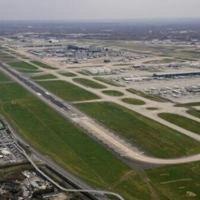Heathrow Airport has officially submitted a comprehensive £49 billion expansion proposal to the UK government, marking a significant milestone in the long-standing debate over the airport’s growth. The ambitious plan centers on the construction of a third runway, estimated to cost £21 billion, alongside major terminal redevelopment and infrastructure upgrades. If approved, the expansion aims to transform Heathrow into a global aviation powerhouse capable of handling up to 150 million passengers annually, almost doubling its current capacity of 84 million.
The new 3,500-metre runway would be situated to the northwest of the existing airport site, allowing for an additional 276,000 flights per year and increasing total air traffic movements from 480,000 to 756,000. This expansion is designed to enhance Heathrow's role as the UK’s primary international gateway, supporting over £200 billion worth of trade and connecting British exporters to 92% of the global economy through direct flights.
The plan also includes the creation of a new terminal complex dubbed “T5X,” which will feature a new processing terminal and a satellite terminal known as “T5XN,” connected via an underground transit system. Terminal 2 will be extended, while Terminal 3 and the old Terminal 1 are set to be demolished as part of the phased redevelopment. These upgrades aim to improve passenger experience, speed up aircraft turnaround times, and increase flight frequency, with at least 30 new daily routes promised, including enhanced domestic connections.
Heathrow’s chief executive, Thomas Woldbye, described the proposal as “shovel ready,” emphasizing the urgency of expansion. “It has never been more important or urgent to expand Heathrow,” he said. “We are effectively operating at capacity to the detriment of trade and connectivity. With a green light from Government and the correct policy support underpinned by a fit-for-purpose regulatory model, we are ready to mobilise and start investing this year in our supply chain across the country. We are uniquely placed to do this for the country; it is time to clear the way for take-off.”
The £49 billion investment is privately funded, with £21 billion allocated for the runway and associated airfield infrastructure, £12 billion for the new terminal, and £15 billion dedicated to modernising existing terminals and facilities. The expansion also includes significant improvements to cargo handling, with capacity expected to increase by 50% through new freight warehouses proposed to the south of the airport.
Surface access improvements are a key feature of the plan. Heathrow proposes rerouting the M25 motorway into a tunnel beneath the new runway between junctions 14 and 15, moving it 130 metres westwards to reduce disruption. Additionally, a new Southern Road Tunnel will link the southern perimeter to the Central Terminal Area, including dedicated bus lanes to unlock previously unviable public transport routes. The airport is also exploring combined rail schemes, such as the Western Rail Link and the long-delayed Southern Rail Access, to enhance connectivity.
Environmental considerations are central to Heathrow’s expansion strategy. The airport has committed to achieving net zero carbon emissions by 2050 and reports progress including a 15% reduction in on-ground carbon and a 10% decrease in flight emissions since 2019. Noise pollution has been reduced by 41% since 2006, and the airport complies with air quality limits. The proposal includes redesigned airspace to provide more predictable flight paths, alongside noise mitigation measures and community funds to support residents affected by the expansion.
Despite government backing and the Supreme Court’s 2020 ruling allowing the third runway to proceed, the plans have met significant opposition. London Mayor Sir Sadiq Khan remains firmly against the expansion, citing the “severe impact” on the capital’s residents. Environmental groups like Friends of the Earth have also voiced strong concerns, with campaigners such as Tony Bosworth warning that backing Heathrow’s expansion would be “the wrong move” for the UK’s climate leadership.
Local residents near Heathrow have expressed fears about the expansion’s impact. Christian Hughes, a resident of Longford, described how his village and others nearby would be “decimated” if the project goes ahead. These concerns are shared by some Labour MPs, despite the Labour government’s support for the runway announced in January 2025, which emphasized the importance of boosting economic growth and export opportunities.
Adding complexity to the debate, the Arora Group, a major Heathrow landowner, submitted a rival expansion proposal on July 31, 2025. Their plan features a shorter 2,800-metre runway intended to avoid the costly and disruptive diversion of the M25 motorway. The Arora Group claims this alternative would reduce risks and costs, presenting a “cost effective” option that could lessen environmental and community impacts.
The UK government, represented by Transport Secretary Heidi Alexander, is reviewing all proposals over the summer, with a formal review of the Airports National Policy Statement expected later this year. Heathrow aims to submit a full planning application by 2028, with construction anticipated to start soon after and the first flights from the new runway projected by the mid-2030s.
Chancellor Rachel Reeves has underscored the expansion’s economic importance, stating it is “essential” to increase airport capacity to ensure British-made goods can be exported worldwide, creating jobs not just around Heathrow but across the UK. Industry groups such as Chambers of Commerce and trade unions have welcomed the plan, highlighting the tens of thousands of jobs expected to be created during the construction and operational phases, with over half the supply chain expenditure targeted outside London and the South East.
However, some airlines have expressed concerns about potential increases in passenger charges to fund the project. EasyJet’s chief executive, Kenton Jarvis, welcomed the expansion as a “unique opportunity” for the airline to scale up operations at Heathrow, potentially leading to lower fares for consumers.
Meanwhile, a Heathrow-funded advocacy group, Back Heathrow, has been active in promoting the expansion, distributing leaflets to thousands of homes in west London. The group claims that the expansion could lead to a “greener” airport, with only the “cleanest and quietest aircraft” operating. Critics have called these claims “incredibly misleading,” pointing to ongoing environmental and social concerns.
The Heathrow expansion saga encapsulates a complex balancing act between economic ambition, environmental responsibility, and community impact. As the government weighs these competing interests, the future of the UK’s busiest airport hangs in the balance, with decisions made in the coming months set to shape the nation’s aviation landscape for decades to come.


